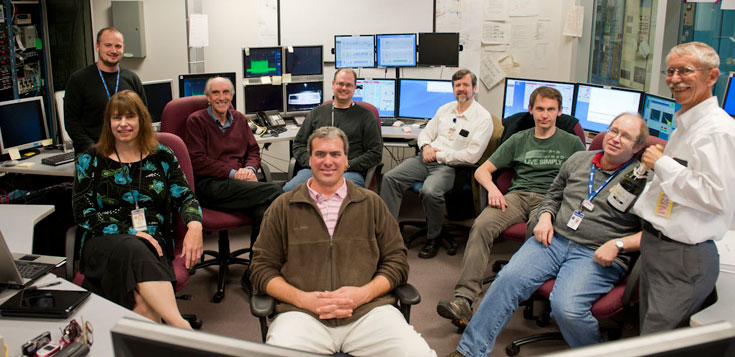NEWPORT NEWS, VA. - December is a time for twinkling lights, and scientists at the Department of Energy's Thomas Jefferson National Accelerator Facility are delivering. They've just produced a long-sought, rare color of laser light 100 times brighter than that generated anywhere else.
The light was produced by Jefferson Lab's Free-Electron Laser facility. The laser delivered vacuum ultraviolet light in the form of 10 eV photons (a wavelength of 124 nanometers). This color of light is called vacuum ultraviolet because it is absorbed by molecules in the air, requiring its use in a vacuum.
"We have succeeded in delivering 10 eV photons for the first time," says George Neil, Jefferson Lab associate director for the FEL Division. "Using a hole out-coupling mirror on the Jefferson Lab Ultraviolet Demonstration FEL, we delivered vacuum ultraviolet harmonic light to a calibrated VUV photodiode and measured five nanojoules of fully coherent light in each micropulse."
The feat opens the door to many lines of research that were previously inaccessible.
For instance, the FEL may soon enable a method of determining the age of materials that far outstrips carbon dating. Radio-carbon dating allows scientists to estimate the age of some materials up to roughly 62,000 years. But radio-krypton dating could potentially allow scientists to determine the age of materials between 100,000 to 1 million years. The 10 eV light from the FEL would be used to produce so-called metastable krypton atoms for use in this dating method. The method can contribute to ocean circulation models and maps of groundwater movement, as well as dating polar ice.
"This new laser is also a perfect tool to study novel materials with great potential for addressing issues such as energy and the environment," said Gwyn Williams, FEL basic research program manager.
"We still have a lot of work ahead of us before experiments can begin," Williams said. "In the new year, we'll be working to deliver light into a lab for measurement and future experiments. We hope to accomplish those goals by March."
The Free-Electron Laser program and individual research projects are supported by various organizations. These include the Department of Defense's Office of Naval Research, the Air Force Research Laboratory and the Joint Technology Office, the Commonwealth of Virginia and the Department of Energy's Basic Energy Sciences. Key equipment was provided by the Wisconsin Synchrotron Radiation Center and Cornell University.

For more information on the Free-Electron Laser:
Free-Electron Laser Goes Over the Rainbow
News Highlights
FEL Program
FEL Status
Researchers' Hottest New Laser Beams 14.2 kW
Contact: Kandice Carter, Jefferson Lab Public Affairs, 757-269-7263, kcarter@jlab.org

